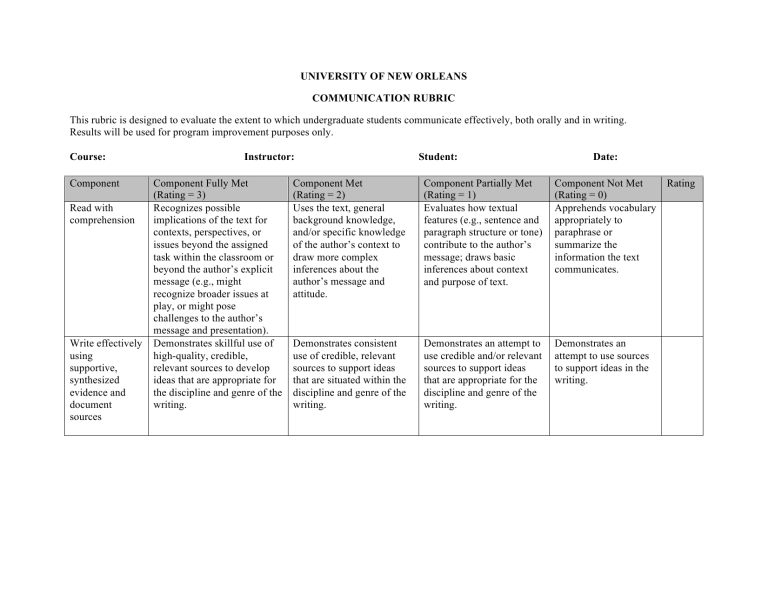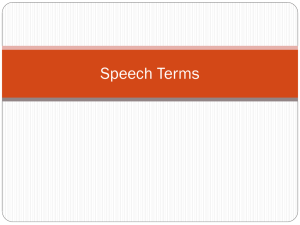
UNIVERSITY OF NEW ORLEANS COMMUNICATION RUBRIC This rubric is designed to evaluate the extent to which undergraduate students communicate effectively, both orally and in writing. Results will be used for program improvement purposes only. Course: Component Read with comprehension Write effectively using supportive, synthesized evidence and document sources Instructor: Component Fully Met (Rating = 3) Recognizes possible implications of the text for contexts, perspectives, or issues beyond the assigned task within the classroom or beyond the author’s explicit message (e.g., might recognize broader issues at play, or might pose challenges to the author’s message and presentation). Demonstrates skillful use of high-quality, credible, relevant sources to develop ideas that are appropriate for the discipline and genre of the writing. Student: Date: Component Met (Rating = 2) Uses the text, general background knowledge, and/or specific knowledge of the author’s context to draw more complex inferences about the author’s message and attitude. Component Partially Met (Rating = 1) Evaluates how textual features (e.g., sentence and paragraph structure or tone) contribute to the author’s message; draws basic inferences about context and purpose of text. Component Not Met (Rating = 0) Apprehends vocabulary appropriately to paraphrase or summarize the information the text communicates. Demonstrates consistent use of credible, relevant sources to support ideas that are situated within the discipline and genre of the writing. Demonstrates an attempt to use credible and/or relevant sources to support ideas that are appropriate for the discipline and genre of the writing. Demonstrates an attempt to use sources to support ideas in the writing. Rating Speak cogently in presenting information Organizational pattern (specific introduction and conclusion, sequenced material within the body, and transitions) is clearly and consistently observable and is skillful and makes the content of the presentation cohesive. Delivery techniques (posture, gesture, eye contact, and vocal expressiveness) make the presentation compelling, and speaker appears polished and confident. Listen effectively Notes: Differentiate between denotation and connotation; recognize irony, metaphorical language, and intentionally misleading language. Develop a framework for organizing the message. Summarize the speaker's purpose. Identify the relative importance of parts of the message and their relevance. Identify and evaluate evidence used to support specific claims. Organizational pattern (specific introduction and conclusion, sequenced material within the body, and transitions) is clearly and consistently observable within the presentation. Organizational pattern (specific introduction and conclusion, sequenced material within the body, and transitions) is intermittently observable within the presentation. Delivery techniques (posture, gesture, eye contact, and vocal expressiveness) make the presentation interesting, and speaker appears comfortable. Delivery techniques (posture, gesture, eye contact, and vocal expressiveness) make the presentation understandable, and speaker appears tentative. Develop a framework for organizing the message. Avoids interrupting speaker. Differentiate between relevant information and information requiring further explanation or analysis. Summarize speaker’s main points when called upon to do so. Take notes paraphrasing salient points. Ask clarifying questions. Integrate the message into his or her own frame of reference. Anticipate forthcoming points. Organizational pattern (specific introduction and conclusion, sequenced material within the body, and transitions) is not observable within the presentation. Delivery techniques (posture, gesture, eye contact, and vocal expressiveness) detract from the understandability of the presentation, and speaker appears uncomfortable. Cannot summarize speaker’s main points when called upon to do so. Cannot integrate message into his or her own frame of reference. Cannot anticipate forthcoming points.


